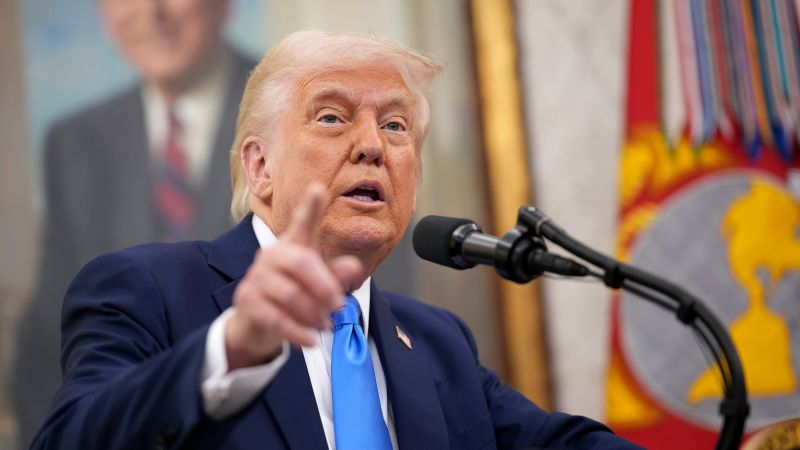New York
CNN
—
On the campaign trail, President Donald Trump vowed to aggressively slap tariffs on US imports as a catch-all solution to almost any problem.
Trump has kept his promise — so much so that it’s freaking out investors, economists, CEOs and a growing segment of the population who fear the import taxes will do more harm than good.
But Trump’s tariff efforts so far might pale in comparison to what’s coming next.
Although many details are unknown, perhaps even to Trump himself, the administration’s “Liberation Day” trade policy announcement is expected to be the most aggressive tariff move yet by the most tariff-obsessed president in modern history.
Trump told reporters late Monday that he’d “settled” on a plan for sweeping new tariffs to be announced midweek, catching some White House officials by surprise: If the president had indeed arrived at a final decision for the tariffs, it hadn’t yet been widely shared inside the building.
Still unclear is whether Trump plans to levy individual tariff rates on all US trading partners; put tariffs on only some countries; or apply a universal tariff — perhaps as high as 20% — on all imports. Trump’s advisers are publicly supportive of Trump’s tariff agenda, but they differ in approach and scope behind the scenes.
A 20% universal tariff — combined with full retaliation from other nations on US goods — would be a “worst-case scenario” for the US economy, Moody’s Analytics chief economist Mark Zandi told CNN on Tuesday.
A Moody’s simulation found that such an escalation in the trade war would wipe out 5.5 million jobs, lift the unemployment rate to 7% and cause US GDP to drop by 1.7% from peak to trough.
“If that happens, we get a serious recession. It’s a wipeout for the economy,” Zandi said, adding that he thinks Trump will announce a less extreme tariff regime to avoid such damage.
Regardless of what Trump ultimately announces, all the proposals would likely be historic.
“We’ve never seen anything like this. It’s unprecedented and radical,” said Erica York, vice president of federal tax policy at the Tax Foundation, a right-leaning think tank.
While previous presidents have lobbed tariffs on steel, tires, electric vehicles or other goods, York said those actions are “nowhere close” to what Trump is setting the stage for on Wednesday.
There are multiple ways Trump’s Liberation Day announcement could play out. One idea is that reciprocal tariffs would start first with the “Dirty 15,” or the 15% of nations that the United States has the biggest trade deficits with. That idea, suggested by Treasury Secretary Scott Bessent, would represent a massive escalation in the trade war.
Still, crucial details of the announcement remain unclear, including how high tariff rates will go, on which products and when they’d kick in. All that is apparent, for the moment at least, is that Trump plans to roll out his signature trade policy from the Rose Garden at 4 pm ET on Wednesday.
Trump has pushed back on tariffs on the “Dirty 15,” instead, throwing his weight behind something far broader.
“You’d start with all countries, so let’s see what happens,” Trump said Sunday. “I haven’t heard a rumor about 15 countries, 10 or 15.”
That suggests Trump’s Liberation Day tariffs won’t be reciprocal as much as they will be universal, reviving a campaign promise (that alarmed economists) to put tariffs on all imports from all nations.
In other words, tariffs would be applied to roughly $3.3 trillion of imported goods, according to last year’s federal trade data.
This is miles away from what Trump did during his first term.
During his entire first four years in the White House, Trump put tariffs on about $380 billion worth of imports, according to the Tax Foundation.

This round of tariffs would be nearly 10 times bigger in scope than what was done Trump’s first term, conjuring the protectionist policy of President William McKinley, who raised taxes on imports to about 50% in the 1890s.
And Trump’s tariffs would be on top of the already very aggressive steps he has already taken this term.
Since taking office in January, Trump has increased tariffs on China by 20%, imposed limited 25% tariffs on Canada and Mexico, and increased tariffs on steel and aluminum to 25%.
The Trump 2.0 tariffs impact more than $1 trillion of imports, more than twice as much as during his entire first term, according to the Tax Foundation. That could rise to $1.4 trillion in the coming days if exemptions for Canada and Mexico are allowed to expire.
Trump has, so far at least, been undeterred by the growing concern across Main Street and Wall Street about his tariff strategy.
Consumer confidence has crumbled, unemployment fears have spiked, and inflation expectations have surged to multidecade highs.
“It’s natural for people to expect higher prices because we haven’t seen a trade war like this since McKinley,” said Art Hogan, chief market strategist at B. Riley Wealth Management.
Recession and stagflation fears
Ahead of Liberation Day, US stocks have dropped sharply as investors try to make sense of the confusing roll-out of the trade plan.
“Tariff uncertainty has put an unexpected stranglehold on markets,” Anthony Saglimbene, Ameriprise’s chief market strategist, wrote in a report Monday.
Wall Street is increasingly worried that Trump’s trade plan will damage the US economy, potentially ending the economic expansion that started in 2020 after the Covid-19 pandemic crash.
“Does President Donald Trump want a recession? He is going to get one if he continues to pursue his chaotic tariff policies,” Ed Yardeni, president of investment strategy firm Yardeni Research, wrote in a report on Monday. “It’s really a shame that Trump is so willing to take a wrecking ball to the economy.”
Yardeni has raised his odds of a stagflation scenario — higher inflation and a possible “shallow” recession — to 45%, up from 35%.
Although Trump touted tariffs on the campaign trail, investors and economists have been caught off guard by how serious he is about them. Many had dismissed his tariff promises as a bluff or a negotiating tactic.
For the second time in less than a month, Goldman Sachs has increased its tariff assumptions. The Wall Street bank now sees a 35% chance of a US recession in the next 12 months, up from 20% previously.
The White House has pushed back on concerns about short-term market and economic turbulence by arguing Trump’s efforts will pay off in the long run.
“The president will be announcing a tariff plan that will roll back the unfair trade practices that have been ripping off our country for decades. He’s doing this in the best interest of the American worker,” White House press secretary Karoline Leavitt told reporters on Monday.
Of course, Trump imposed tariffs during his first term and the US economy did not suffer stagflation or a recession (though it was weakening as the pandemic struck).
But the world is very different today. Inflation is much higher, as are interest rates. Central bankers, investors and consumers are much more sensitive to price changes.
And what Trump is doing is far more aggressive.
“I wouldn’t be surprised if the average person didn’t notice tariffs during Trump’s first term in their day-to-day lives,” said York, the Tax Foundation executive. “But what we’re talking about now would be so broad that it would be impossible not to notice it.”

Some businesses are already noticing the impact, and they’re frustrated by all the chaos.
“Trump, tariffs, massive uncertainty—how can you do business planning with all of this uncertainty and the daily changes in direction made by the Trump administration?” one computer and electronic manufacturer told the Federal Reserve Bank of Dallas in a survey released Monday.
A mineral product manufacturer similarly complained about the question marks swirling around the economy.
“Tariffs! We need to make decisions, but the ball is constantly moving. This is truly ridiculous,” the manufacturing executive wrote. “I have been in business for 50 years as of next year, and never have I seen such uncertainty in the market.”
York worries the only “silver lining” of universal tariffs would be that people will realize how dangerous tariffs can be. She compared it with a child who touches a stove and quickly finds out how hot it is.
“We will learn a very hard lesson very fast and maybe not make the mistake again,” York said.

